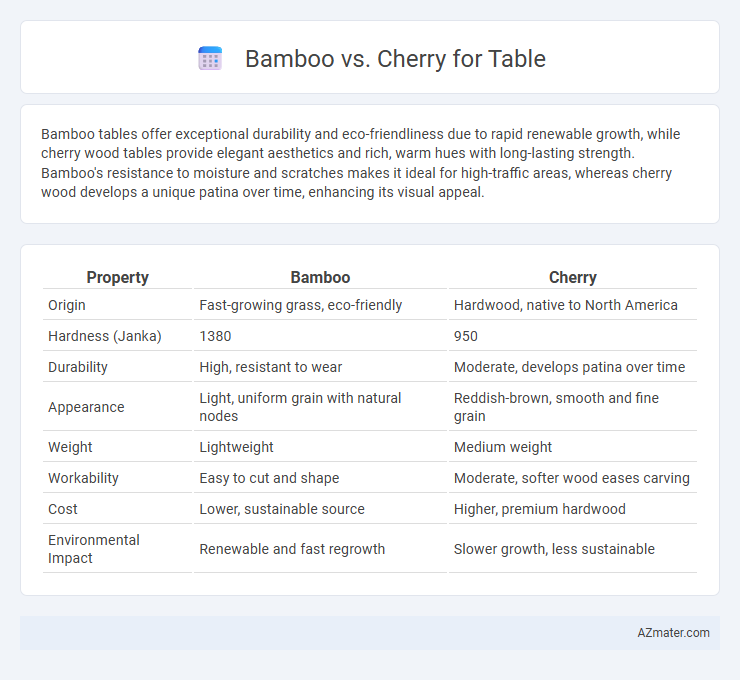Bamboo tables offer exceptional durability and eco-friendliness due to rapid renewable growth, while cherry wood tables provide elegant aesthetics and rich, warm hues with long-lasting strength. Bamboo's resistance to moisture and scratches makes it ideal for high-traffic areas, whereas cherry wood develops a unique patina over time, enhancing its visual appeal.
Table of Comparison
| Property | Bamboo | Cherry |
|---|---|---|
| Origin | Fast-growing grass, eco-friendly | Hardwood, native to North America |
| Hardness (Janka) | 1380 | 950 |
| Durability | High, resistant to wear | Moderate, develops patina over time |
| Appearance | Light, uniform grain with natural nodes | Reddish-brown, smooth and fine grain |
| Weight | Lightweight | Medium weight |
| Workability | Easy to cut and shape | Moderate, softer wood eases carving |
| Cost | Lower, sustainable source | Higher, premium hardwood |
| Environmental Impact | Renewable and fast regrowth | Slower growth, less sustainable |
Introduction to Bamboo and Cherry Wood
Bamboo is a highly renewable grass known for its rapid growth and exceptional strength, making it an eco-friendly option for tables with a distinctive, light-toned appearance. Cherry wood, sourced from the American Black Cherry tree, offers a rich reddish-brown hue that deepens with age and is prized for its smooth grain and durability. Both materials provide unique aesthetic and functional qualities, with bamboo emphasizing sustainability and cherry highlighting traditional elegance.
Sustainability: Bamboo vs Cherry
Bamboo is highly sustainable due to its rapid growth rate, reaching maturity in 3-5 years, which allows for frequent harvesting without deforestation. Cherry wood, by contrast, grows much slower, often taking 30-40 years to mature, making it less renewable and more susceptible to overharvesting. Bamboo's ability to regenerate quickly and its minimal need for pesticides and fertilizers make it an eco-friendly choice for tables compared to the slower regeneration cycle of cherry wood.
Appearance and Grain Patterns
Bamboo tables exhibit a uniform, linear grain pattern with a light, natural color that enhances minimalist and modern decor styles. Cherry wood features rich, deep reddish-brown tones with distinctive, flowing grain patterns that darken over time, adding warmth and elegance. The contrasting textures make bamboo ideal for sleek, contemporary furniture, while cherry suits traditional and classic settings.
Durability and Hardness Comparison
Bamboo tables offer impressive durability due to their dense fiber structure, often achieving a Janka hardness rating of around 1,380, making them resistant to dents and scratches. Cherry wood tables, with a Janka hardness of approximately 995, provide a softer surface that develops a rich patina over time but is more prone to surface wear and dents. For environments demanding higher surface resilience and long-term robustness, bamboo stands out as the superior choice, while cherry adds warmth and aesthetic appeal with moderate durability.
Maintenance and Care Requirements
Bamboo tables require minimal maintenance, needing only regular dusting and occasional wiping with a damp cloth to prevent dirt buildup. Cherry wood tables demand more care, including periodic polishing with wood-specific products to maintain their rich color and prevent drying or cracking. Both materials benefit from avoiding direct sunlight and excessive moisture to preserve their longevity and appearance.
Cost and Affordability
Bamboo tables typically offer a more affordable option compared to cherry wood, with prices ranging from $100 to $300 for standard sizes, while cherry wood tables commonly start at $300 and can exceed $1,000 depending on quality and craftsmanship. Bamboo's rapid growth and sustainability contribute to its lower cost, making it a budget-friendly choice for eco-conscious consumers. Cherry wood's durability and rich color, however, justify its higher price point for those prioritizing long-term investment and aesthetic appeal.
Environmental Impact and Renewability
Bamboo offers a significantly lower environmental impact than cherry wood due to its rapid growth rate and high renewability, allowing it to be harvested every 3-5 years without deforestation. Cherry trees require decades to mature, leading to slower replenishment and increased carbon footprint associated with logging and transportation. Using bamboo for tables supports sustainable forestry practices and reduces habitat disruption, making it a more eco-friendly choice compared to traditional hardwoods like cherry.
Best Uses for Dining and Coffee Tables
Bamboo offers exceptional durability and moisture resistance, making it ideal for dining tables exposed to frequent spills and heavy use, while its sustainable growth cycle appeals to eco-conscious buyers. Cherry wood is prized for its rich reddish-brown color and smooth grain, providing a warm, elegant aesthetic perfect for coffee tables that serve as focal points in living rooms. Both materials balance strength and beauty, but bamboo excels in high-traffic dining settings, whereas cherry enhances cozy, decorative coffee table designs.
Design Versatility and Style Options
Bamboo offers exceptional design versatility with its natural grain patterns and the ability to be molded into various shapes, providing a modern aesthetic for tables. Cherry wood is prized for its rich, warm tones and fine grain, which develop deeper hues over time, making it ideal for classic and elegant table styles. Both materials accommodate diverse stylistic preferences, but bamboo's eco-friendly appeal and flexibility contrast with cherry's traditional luxury and durability.
Final Verdict: Which Is Better for Tables?
Bamboo offers superior sustainability and exceptional durability, making it an eco-friendly choice for tables due to its rapid growth and natural hardness. Cherry wood provides rich aesthetics with a smooth texture and ages beautifully, developing a warm patina over time that enhances its appeal. For a balance of environmental benefits and resilience, bamboo is often preferred, while cherry excels in offering classic elegance and long-term character for traditional settings.

Infographic: Bamboo vs Cherry for Table
 azmater.com
azmater.com